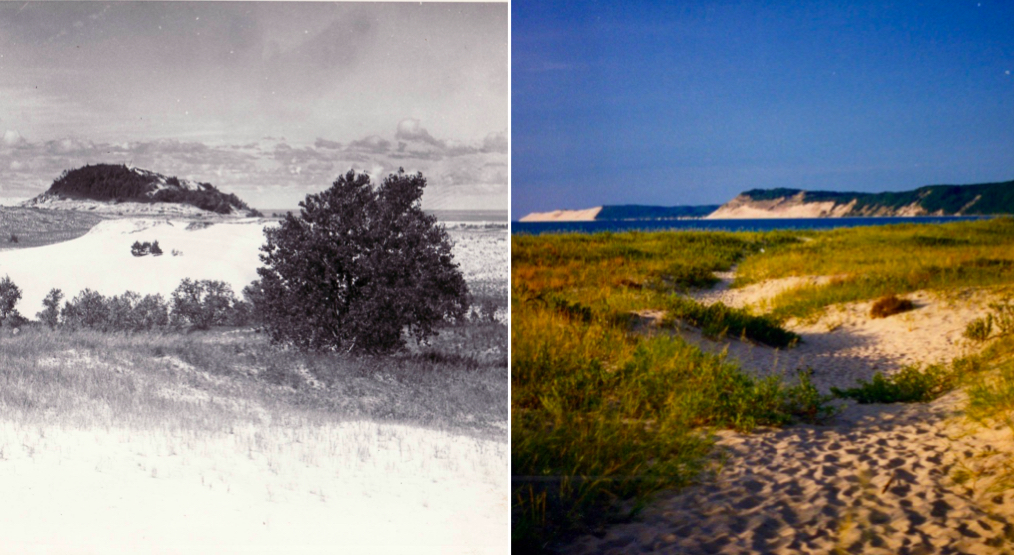
Legend Behind The Legend? Hear Surprising Backstory From A Sleeping Bear Scholar Tracking Its Origin
By Emily Tyra | May 19, 2021
Most who live in Leelanau County or visit its coast have heard the legend of Sleeping Bear, the origin story of the colossal sand dune and the two Manitou Islands: The mother bear rests on shore in constant watch over her two bear cubs, who drowned while crossing Lake Michigan. It's a well-loved tale told for generations, with a version made the Official State Children’s Book of Michigan. But it turns out tracking its beginnings is quite a story onto itself.
Attempting to find its source is Traverse City folklorist and MSU College of Education curriculum pioneer Eliot Singer, who spends summers in Leelanau County.
“In recent years,” he says, “I’ve read and heard various comments from members of the Grand Traverse Band, mostly favorable about the story but critical about how it has been popularized.”
Singer says the “legend” is not typical of Anishinaabe landscape origin and other sacred stories, which are reflective of social, existential, and moral dilemmas. “When I first came across the legend of Sleeping Bear, the best-known tourist legend in Michigan, I dismissed it as ‘fakelore.’ Researching, I found it to be much more interesting.”
One of his goals now: to better familiarize people with more typical Anishinaabe landscape origin and bear stories. One he shared with the Leelanau Ticker, “The Great Muckwah,” does indeed involve a sleeping bear -- but one that’s a violent menace to villages up and down the Michigan coast, until it is finally overpowered by a young maiden who uses a potion to put the bear gently to sleep.
Here, the bear known as “The Great Muckwah” was definitely not the “mama bear” type. But perhaps even more of a stunner: The story makes zero reference to the Manitou Islands.
“The islands have been known as Manitous to natives and travelers alike for as long as there is documentation but, the mother-and-cubs legend [whose first known printing was in the Detroit Free Press, Sunday, January 23, 1891, an article titled, “An Indian Legend: The Traditions Concerning Sleeping Bear Point and the Manitou Islands”] is the only connection between the dune and the islands of which I am aware,” says Singer.
But that version was promoted to the exclusion of “The Great Muckwah” and other stories. Singer says the conceptual connection between the Manitous and Sleeping Bear became popular because it fits the romantic stereotype of what native stories are about: “The romantic stereotype for native origin legends is that enduring love is rewarded by the creation of something beautiful — a flower, star, scenic place.”
Meanwhile, “Traditional landscape origins were usually funny or violent instead.”
Tomorrow night (May 20) at 7pm, in a virtual event hosted by the Leelanau Historical Society, Singer will be sharing a few PG-rated translations of these funny, violent, and sacred stories of the Anishinaabe, as well as what he believes to be the “complicated provenance of a story that was told, and continued to be told, within the Little Traverse Odawa community before it became a popular tourist legend.”
You read that “Little” right: According to Singer, the versions of the legend of Sleeping Bear documented from native communities before it became widely popular are all from Little Traverse Odawa, near Harbor Springs, quite a hike from the Sleeping Bear Dunes themselves.
He explains that all of west Michigan’s Chippewa and Odawa would have been familiar with the dunes and the landscape along the coast of Lake Michigan. And as he shares,“Frank Ettawageshik, long-time leader within the Little Traverse Bay Bands has said, ‘It is not a tourist thing. It is a favorite story of generations of my people.’”
Ettawageshik is a traditional storyteller and potter, the former tribal chairman of the Little Traverse Bay Bands of Odawa Indians in Harbor Springs and president of the Association on American Indian Affairs. Singer says tradition bearers in Ettawageshik’s family, among other Odawa, told the legend of the Sleeping Bear. One oral telling, recorded about 1950, was by Old Jawinikom, who lived near Charlevoix. Singer says, “He considered the story as ‘for a Papoose,’ i.e., for young children.”
Singer says that is likely because it lacks the level of complexity and sophistication of Native American stories that were told traditionally to children and adults alike.
As a scholar, Singer proposes that the legend was crafted, circa 1870, by a bicultural storyteller, familiar with Greek mythology, who had close ties to the Odawa. Her name is Sophia Bailly Graveraet, and she endured the loss of her own son. “My suspected author is a very interesting woman who deserves more research,” he says.
“She was born in 1807, the daughter of Joseph Bailly, a fur trader, and Angelique McGulpin…who had family among Little Traverse Odawa.”
He says she was raised on Mackinac Island after her parents split, as goddaughter of the famed Madame LaFromboise, credited as the first female millionaire in North America.
She married Henry Graveraet Jr., and moved to Harbor Springs just before the Civil War. Their son Garrett commanded Company K, the most famous Native America unit in the Union Army.
Singer asks, “Could Graveraet have created a poignant romance for her grandchildren, to mourn her son, then shared it with friends in the Little Traverse Odawa community who gradually adapted it as one their own?”
He’ll share his work tracking the Sleeping Bear legend and more tomorrow night.
Leelanau Historical Society Executive Director Kim Kelderhouse invites anyone captivated by the story of the Sleeping Bear Dunes to join. She tells the Leelanau Ticker, “Local history sometimes tends to repeat stories that are not a complete version of the truth. It is important to…understand the scope of history and to accurately present the cultures and people who ‘wrote’ that history.”
See the historical society’s current summer event lineup on its website. Register for the May 20, 7pm Zoom presentation “Tracking The Sleeping Bear” here.
Pictured: Left, a vintage view of what was referred to as “the Bear” or “the pinnacle,” the mound of sand at the very highest point of the Sleeping Bear Dunes (courtesy Leelanau Historical Society). Right, Sleeping Bear Dunes — 25 years ago when lake levels were lower — taken from Platte Bay, by Eliot Singer.
CommentTuesday Filing Deadline Brings County Election Races Into Focus
Though early signs indicated a concerningly sparse field for this year’s impending Leelanau County Board of Commissioners ...
Read More >>The Latest Leelanau County Blotter & 911 Call Report
The Leelanau Ticker is back with a look at the most alarming, offbeat, or otherwise newsworthy calls ...
Read More >>Barge Owner Pleads Guilty, Gets One Year To Move Vessel
Donald Balcom, the owner of a decrepit barge that has been repeatedly abandoned at numerous points around ...
Read More >>Polka Kings Of The Midwest: The Past, Present, And Future Of The Cedar Polka Fest
The 42nd annual Cedar Polka Fest may still be four months out, but organizers are already gearing ...
Read More >>



